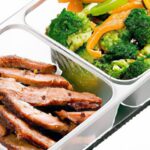In today’s fast-paced world, understanding what fuels our bodies is more important than ever. Yet, the maze of nutritional labels on food packaging can feel like an indecipherable code, leaving many of us guessing rather than knowing. Welcome to “Decode Nutrition: Master Labels to Track Calories & Macros,” where we unravel the mysteries behind those tiny print details. By mastering how to read and interpret nutrition labels, you’ll gain the power to make smarter, informed choices-whether your goal is to shed pounds, build muscle, or simply eat healthier. Get ready to transform confusing jargon into clear insights that put you in full control of your nutrition journey.
Decode Nutrition: Master Labels to Track Calories & Macros
Decoding the nutrition label is like unlocking a secret culinary map-a powerful tool that transforms how you plan meals, understand energy intake, and make smart food choices every day. Whether you’re aiming to sculpt your physique, manage health conditions, or simply eat cleaner, mastering the details behind calories and macros gives you a vital edge in the kitchen and at the grocery store.
Prep and Cook Time
- Preparation: 5 minutes
- No cooking required
Yield
- Serves 1 curious label decoder
Difficulty Level
- Easy – perfect for beginners and seasoned meal planners alike
Essential Ingredients for Label Decoding
- 1 nutrition label on your favorite packaged food
- 1 magnifying glass or smartphone camera (for finer print)
- 1 notebook or app to jot down calories and macros
- 1 measuring utensil – such as a teaspoon or cup
- A pinch of curiosity and a dash of patience
Instructions: Step-by-Step Guide to Crack Your Next Nutrition Label
- Start with the serving size. It’s the foundation for accurate calorie and macro tracking. Note whether it’s in grams, cups, or pieces-the form matters. Remember, all nutritional info relates to this portion.
- Check calories per serving. This tells you the fuel your body will get. To harness the power of Decode Nutrition: Master Labels to Track Calories & Macros, compare the calories with your daily targets to keep balanced.
- Break down macros-protein, carbohydrates, and fats. These are your body’s primary energy sources and building blocks. Spotting hidden sugars or excess saturated fat can drastically improve choices.
- Spot common label tricks. Watch for “serving packs” within a single container or ambiguous terms like “multi-grain” (which doesn’t guarantee whole grains). Also, scrutinize “calories from fat” versus total fat to understand fat type quality.
- Use precise macro tracking. Applications like MyFitnessPal or Cronometer can help to log the information directly, but always crosscheck with the actual label to avoid errors from generic entries.
- Adjust your portions and plan meals. Understanding labels empowers you to tailor your diet by swapping ingredients or scaling quantities while keeping macros in balance.
Tips for Success: Elevate Your Label Reading Game
- Know your nutrients: Beyond calories and macros, fibre, sodium, and added sugars impact your overall health.
- Beware “health halos”: Words like “low-fat” or “natural” don’t guarantee low calories or good macros-always double-check.
- Practice makes perfect: Pick a few labels each week to decode thoroughly and boost your confidence.
- Store your findings: Build a personal database of favorite foods with their macros for quick meal prep.
- Consider timing: Macro needs shift depending on your activity and goals; adjust accordingly rather than sticking rigidly to static targets.
- Use visual triggers: Highlight or underline key numbers directly on packaging with a removable marker to streamline future reference.
Serving Suggestions: How to Use Your Decoding Skills Daily
- Meal batching: Plan a week’s menu based on macro targets, using labels to balance meals rather than guesswork.
- Snack smart: Decode processed snacks to find hidden sugars or fats-then swap with whole, nutrient-dense options as you refine your diet.
- At the grocery store, challenge yourself to pick up unfamiliar products and decode their labels right on the spot-turn shopping into an empowering, educational experience.
- Share your knowledge: Use your new skills to help family and friends make healthier choices and demystify confusing packaging.

| Nutrient | Typical Value per Serving | Role in Your Body |
|---|---|---|
| Calories | 180 kcal | Energy supply to carry out daily activities. |
| Protein | 12 g | Supports muscle repair and immune function. |
| Carbohydrates | 22 g | Primary energy source, choose complex carbs. |
| Fats | 7 g | Essential for hormone health and nutrient absorption. |
| Fiber | 4 g | Promotes digestive health and satiety. |
To dive deeper into smart label reading techniques, explore our comprehensive meal planning guide that complements this knowledge perfectly. For more on nutritional science, visit The Nutrition Society, a trusted resource on cutting-edge dietary research and best practices.
Q&A
Q&A: Decode Nutrition – Master Labels to Track Calories & Macros
Q1: Why is decoding nutrition labels important for tracking calories and macros?
A: Nutrition labels are like treasure maps-they reveal exactly what’s inside your food. By mastering them, you gain control over your calorie intake and macronutrient balance, helping you fuel your body right for energy, muscle, or weight goals.
Q2: What are the key components to look for on a nutrition label?
A: Start with serving size-it’s the lens through which all numbers make sense. Then check calories, total fat, carbohydrates, and protein. Don’t forget fiber and sugars for carbohydrate quality, and watch sodium to keep salt intake in check.
Q3: How can serving size trick you if you’re not careful?
A: One package often contains multiple servings, so if you eat the entire thing, you must multiply calories and macros accordingly. It’s easy to underestimate how much you really consume without this step.
Q4: What’s the difference between total carbs and net carbs on labels?
A: Total carbs include everything-fiber, sugars, and starches. Net carbs = total carbs minus fiber, highlighting the carbs that impact blood sugar. This is especially useful for keto or low-carb diets.
Q5: How do you use nutrition labels to optimize your macro goals?
A: Calculate your daily target macros, then use labels to track each meal’s contribution. For instance, if you need 150g protein daily, check protein per serving and plan accordingly to hit that number steadily throughout the day.
Q6: Can relying solely on nutrition labels be misleading?
A: Labels are guides, not gospel. Ingredients quality matters too-whole, minimally processed foods often provide better nutrition than the numbers alone suggest. Use labels as one piece of a healthy eating puzzle.
Q7: Are there any hidden calories we might miss on labels?
A: Sometimes added oils, sauces, or toppings aren’t fully accounted for. Cooking methods can also add calories, so when tracking meticulously, factor in these extras to avoid surprises.
Q8: What tips do you have for mastering label reading quickly?
A: Practice spotting serving size first, then scan calories and macros. Use apps or notes to compare similar foods. Over time, you’ll develop a sixth sense for nutrition labels that streamlines your food choices.
By mastering the language of nutrition labels, you hold the key to unlocking your dietary goals-one serving at a time!
Key Takeaways
In the ever-evolving world of nutrition, mastering the art of reading labels is your secret weapon. By decoding the numbers and ingredients, you empower yourself to make choices that align with your goals and fuel your body efficiently. Remember, every calorie and macro tells a story-one that, when understood, transforms grocery shopping from a guessing game into a strategic journey. So next time you reach for that package, let the label be your guide, unlocking a path to smarter eating and a healthier you. Your nutrition decoded, your journey mastered.








